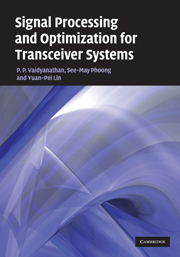
-
Select format
-
- Publisher:
- Cambridge University Press
- Publication date:
- 05 August 2011
- 11 March 2010
- ISBN:
- 9781139042741
- 9780521760799
- Dimensions:
- (247 x 174 mm)
- Weight & Pages:
- 1.85kg, 874 Pages
- Dimensions:
- Weight & Pages:
You may already have access via personal or institutional login
Book description
Presenting the first complete treatment of MIMO transceiver optimization, this self-contained book provides all the mathematical information needed to understand transceiver optimization in a single volume. It begins with a review of digital communication fundamentals, and then moves on to a detailed study of joint transceiver optimization, starting from simple single-input single-output channels all the way to minimum bit error rate transceivers for MIMO channels. Crucial background material is covered, such as Schur convex functions, matrix calculus, and constrained optimization, together with eight appendices providing further background material on topics such as matrix theory, random processes, and sampling theory. A final ninth appendix provides a grand summary of all the optimization results. With 360 illustrations, over 70 worked examples, and numerous summary tables provided to aid understanding of key concepts, this book is ideal for graduate students, practitioners, and researchers in the fields of communications and signal processing.
Reviews
"Surprisingly, there are very few textbooks that cover this area in its entirety and with the necessary mathematical rigor. The authors managed to fill this gap with great aptitude. A long list of references and a comprehensive index make this self-contained companion for researchers and advanced graduate students perfect." Computing Reviews
Contents
Metrics
Full text views
Full text views help Loading metrics...
Loading metrics...
* Views captured on Cambridge Core between #date#. This data will be updated every 24 hours.
Usage data cannot currently be displayed.
Accessibility standard: Unknown
Why this information is here
This section outlines the accessibility features of this content - including support for screen readers, full keyboard navigation and high-contrast display options. This may not be relevant for you.
Accessibility Information
Accessibility compliance for the PDF of this book is currently unknown and may be updated in the future.


